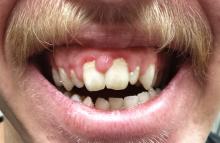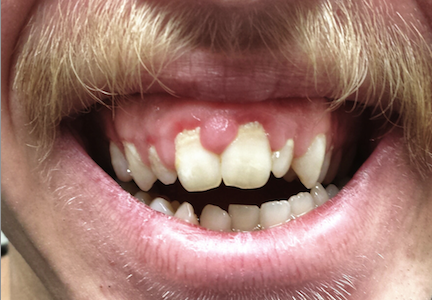User login
An 18-year-old boy is brought by his parents for evaluation of several relatively minor skin problems, including warts, moles, and skin tags. The patient’s history is notable for multiple as-yet-unexplained bony fractures that have occurred with minimal trauma since he was born. He has a brother who was diagnosed with osteogenesis imperfecta, yet, despite an extensive workup, the patient’s constellation of findings has thus far failed to corroborate that or any other definitive diagnosis.
As an afterthought, the parents also ask about changes they have noted on the patient's gums.
There is no history of seizures, and the patient takes no medication regularly.
EXAMINATION
The potential connection to a heritable syndrome draws attention to the patient’s teeth and gums. The latter appear to be overgrown and, as such, far more prominent than normal. They also appear a bit inflamed, especially the portion of the gingiva bordering the teeth. Advanced gingival recession is noted in some of these locations. Closer examination reveals extensive plaque formation on the adjacent teeth.
During the exam, the patient is observed to be a mouth-breather. His parents corroborate this fact.
Continue for Joe Monroe's discussion and learning points >>
DISCUSSION
The most common cause of gingival overgrowth (GO) is thought to be gingivitis, itself a result of inflammation caused by dental plaque and plaque-associated bacteria. The obvious gingivitis, gingival recession, and extensive dental plaque seen in this patient are more common in younger, mouth-breathing persons. Higher levels of growth hormone might account for the gingival growth, while the dehydration of teeth and gums promoted by mouth-breathing appears to exacerbate gingivitis.
Formerly called gingival hyperplasia, the term gingival overgrowth has been posited as more inclusive of all forms of such findings. Advocates of this change in terminology point out that confirmation of the diagnosis of gingival hypertrophy (an increase in the size of individual cells) or gingival hyperplasia (an increase in the number of cells) would require biopsy and microscopic examination.
Three major categories of potential causes of GO are commonly described in the literature. They include (in descending order of frequency):
1. Inflammation: such as that described, with apparent connection with gingivitis
2. Drugs: A number of medications have been associated with GO, including anticonvulsants such as phenytoin (approximately 50% of cases), calcium channel blockers such as nifedipine (20%), and immunosuppressants such as cyclosporine (30%).
3. Systemic causes: These include pregnancy, puberty, vitamin C deficiency, leukemia, and granulomatous diseases such as Wegener granulomatosis. It can also manifest as a perineoplastic sign (associated with known or occult cancers).
Treatment, of course, depends on the cause. Even when drugs are to blame, however, co-existing gingivitis can be a contributing factor; it can be addressed with plaque scaling, better dental care, or even gingivectomy. Drugs can be changed or eliminated or doses can be reduced. Other, less common systemic conditions associated with GO can be sought through additional history, laboratory work, and more extensive examination.
TAKE-HOME LEARNING POINTS
• The term gingival hypertrophy is being replaced by the more inclusive gingival overgrowth (GO).
• The most common cause of GO is chronic gingivitis.
• Drug classes associated with GO include anticonvulsants, calcium channel blockers, and immunosuppressants.
• Systemic diseases can trigger GO; these include pregnancy, puberty, and cancer (eg, leukemia).
• Addressing oral hygiene is a good place to start treatment of GO, regardless of the trigger, since it often co-exists with other causation.
An 18-year-old boy is brought by his parents for evaluation of several relatively minor skin problems, including warts, moles, and skin tags. The patient’s history is notable for multiple as-yet-unexplained bony fractures that have occurred with minimal trauma since he was born. He has a brother who was diagnosed with osteogenesis imperfecta, yet, despite an extensive workup, the patient’s constellation of findings has thus far failed to corroborate that or any other definitive diagnosis.
As an afterthought, the parents also ask about changes they have noted on the patient's gums.
There is no history of seizures, and the patient takes no medication regularly.
EXAMINATION
The potential connection to a heritable syndrome draws attention to the patient’s teeth and gums. The latter appear to be overgrown and, as such, far more prominent than normal. They also appear a bit inflamed, especially the portion of the gingiva bordering the teeth. Advanced gingival recession is noted in some of these locations. Closer examination reveals extensive plaque formation on the adjacent teeth.
During the exam, the patient is observed to be a mouth-breather. His parents corroborate this fact.
Continue for Joe Monroe's discussion and learning points >>
DISCUSSION
The most common cause of gingival overgrowth (GO) is thought to be gingivitis, itself a result of inflammation caused by dental plaque and plaque-associated bacteria. The obvious gingivitis, gingival recession, and extensive dental plaque seen in this patient are more common in younger, mouth-breathing persons. Higher levels of growth hormone might account for the gingival growth, while the dehydration of teeth and gums promoted by mouth-breathing appears to exacerbate gingivitis.
Formerly called gingival hyperplasia, the term gingival overgrowth has been posited as more inclusive of all forms of such findings. Advocates of this change in terminology point out that confirmation of the diagnosis of gingival hypertrophy (an increase in the size of individual cells) or gingival hyperplasia (an increase in the number of cells) would require biopsy and microscopic examination.
Three major categories of potential causes of GO are commonly described in the literature. They include (in descending order of frequency):
1. Inflammation: such as that described, with apparent connection with gingivitis
2. Drugs: A number of medications have been associated with GO, including anticonvulsants such as phenytoin (approximately 50% of cases), calcium channel blockers such as nifedipine (20%), and immunosuppressants such as cyclosporine (30%).
3. Systemic causes: These include pregnancy, puberty, vitamin C deficiency, leukemia, and granulomatous diseases such as Wegener granulomatosis. It can also manifest as a perineoplastic sign (associated with known or occult cancers).
Treatment, of course, depends on the cause. Even when drugs are to blame, however, co-existing gingivitis can be a contributing factor; it can be addressed with plaque scaling, better dental care, or even gingivectomy. Drugs can be changed or eliminated or doses can be reduced. Other, less common systemic conditions associated with GO can be sought through additional history, laboratory work, and more extensive examination.
TAKE-HOME LEARNING POINTS
• The term gingival hypertrophy is being replaced by the more inclusive gingival overgrowth (GO).
• The most common cause of GO is chronic gingivitis.
• Drug classes associated with GO include anticonvulsants, calcium channel blockers, and immunosuppressants.
• Systemic diseases can trigger GO; these include pregnancy, puberty, and cancer (eg, leukemia).
• Addressing oral hygiene is a good place to start treatment of GO, regardless of the trigger, since it often co-exists with other causation.
An 18-year-old boy is brought by his parents for evaluation of several relatively minor skin problems, including warts, moles, and skin tags. The patient’s history is notable for multiple as-yet-unexplained bony fractures that have occurred with minimal trauma since he was born. He has a brother who was diagnosed with osteogenesis imperfecta, yet, despite an extensive workup, the patient’s constellation of findings has thus far failed to corroborate that or any other definitive diagnosis.
As an afterthought, the parents also ask about changes they have noted on the patient's gums.
There is no history of seizures, and the patient takes no medication regularly.
EXAMINATION
The potential connection to a heritable syndrome draws attention to the patient’s teeth and gums. The latter appear to be overgrown and, as such, far more prominent than normal. They also appear a bit inflamed, especially the portion of the gingiva bordering the teeth. Advanced gingival recession is noted in some of these locations. Closer examination reveals extensive plaque formation on the adjacent teeth.
During the exam, the patient is observed to be a mouth-breather. His parents corroborate this fact.
Continue for Joe Monroe's discussion and learning points >>
DISCUSSION
The most common cause of gingival overgrowth (GO) is thought to be gingivitis, itself a result of inflammation caused by dental plaque and plaque-associated bacteria. The obvious gingivitis, gingival recession, and extensive dental plaque seen in this patient are more common in younger, mouth-breathing persons. Higher levels of growth hormone might account for the gingival growth, while the dehydration of teeth and gums promoted by mouth-breathing appears to exacerbate gingivitis.
Formerly called gingival hyperplasia, the term gingival overgrowth has been posited as more inclusive of all forms of such findings. Advocates of this change in terminology point out that confirmation of the diagnosis of gingival hypertrophy (an increase in the size of individual cells) or gingival hyperplasia (an increase in the number of cells) would require biopsy and microscopic examination.
Three major categories of potential causes of GO are commonly described in the literature. They include (in descending order of frequency):
1. Inflammation: such as that described, with apparent connection with gingivitis
2. Drugs: A number of medications have been associated with GO, including anticonvulsants such as phenytoin (approximately 50% of cases), calcium channel blockers such as nifedipine (20%), and immunosuppressants such as cyclosporine (30%).
3. Systemic causes: These include pregnancy, puberty, vitamin C deficiency, leukemia, and granulomatous diseases such as Wegener granulomatosis. It can also manifest as a perineoplastic sign (associated with known or occult cancers).
Treatment, of course, depends on the cause. Even when drugs are to blame, however, co-existing gingivitis can be a contributing factor; it can be addressed with plaque scaling, better dental care, or even gingivectomy. Drugs can be changed or eliminated or doses can be reduced. Other, less common systemic conditions associated with GO can be sought through additional history, laboratory work, and more extensive examination.
TAKE-HOME LEARNING POINTS
• The term gingival hypertrophy is being replaced by the more inclusive gingival overgrowth (GO).
• The most common cause of GO is chronic gingivitis.
• Drug classes associated with GO include anticonvulsants, calcium channel blockers, and immunosuppressants.
• Systemic diseases can trigger GO; these include pregnancy, puberty, and cancer (eg, leukemia).
• Addressing oral hygiene is a good place to start treatment of GO, regardless of the trigger, since it often co-exists with other causation.

